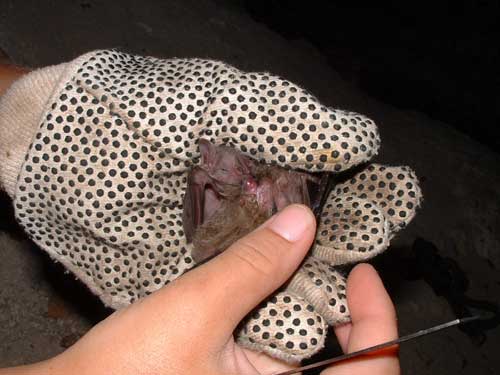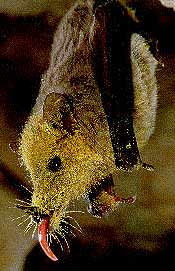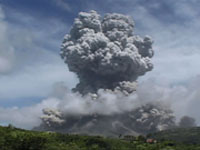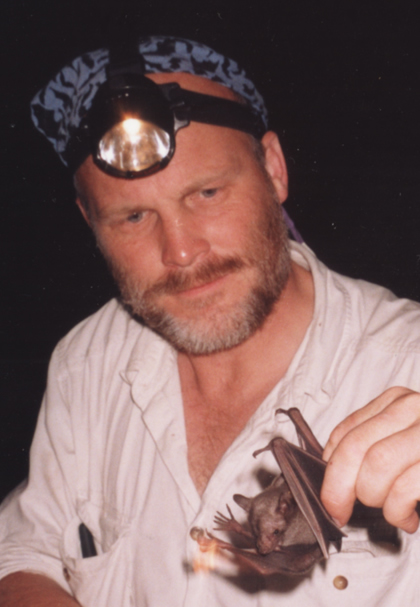Short Guide to the Bats the (northern) Lesser Antilles
by S. Pedersen and M. Morton
Updated 1.2019
INTRODUCTION This introductory guide is designed for lay-scientists and the general public. It is intended to stimulate interest in these fascinating, secretive animals. Bats (Chiroptera) are mammals, they have fur and suckle their live-born young on milk. Worldwide there are over 1200 different species of bat -- one-quarter of all mammalian species. They are the only mammals that are capable of self-powered flight upon wings made of long fingers that are webbed with very thin sheet os elastic skin.
For the most-part, bats in the region either eat fruit or insects, and only both in extreme circumstances. In fact, bats eat many of the same things that birds eat, albeit they do it at night (consider humming birds and the nectar-drinking bats).
There are no dangerous bats in the northern Lesser Antilles, though many can be a nuisance when they live in the ceiling of your home. Bats are not a threat to anyone and will only bite if you attempt to pick them up. If you are bitten by a bat, wash the wound thoroughly and report it to a doctor, as you should for a bite from any wild animal. Although parts of this guide (including the key at the bottom) tell you how to identify bats in the hand, this is only intended for people who have been trained to do so.
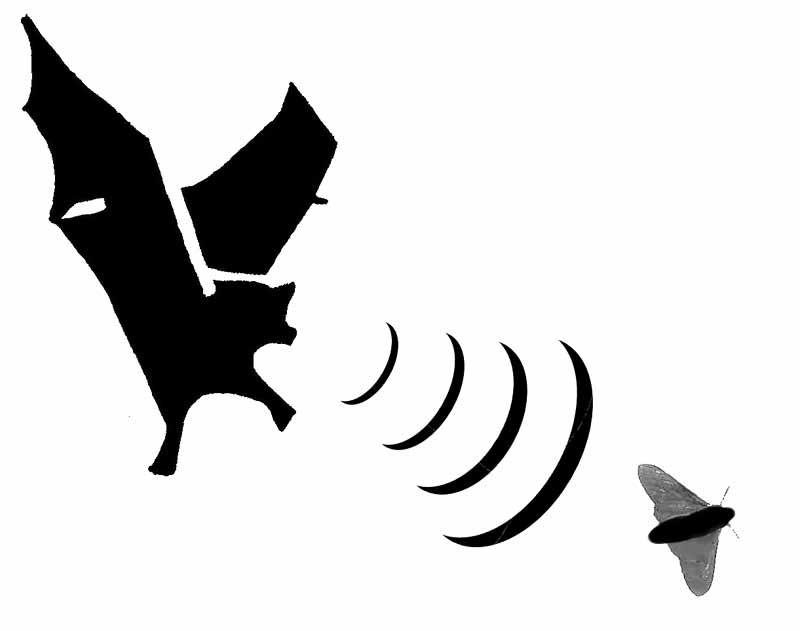
ECHOLOCATION Bats have perfectly good eyesight, but most bats also use "echolocation" to navigate in the darkness. Echolocation is a kind of biological radar system that involves the bat calling out sounds that are too high-pitched for the human ear to detect. These high-pitched sounds bounce off of objects (obstacles, insects, mangoes) and return to the bat as an echo. By listening to how long it takes for echoes to bounce back, bats learn how far away objects are, even if they can't see them with their eyes. In this way bats can chase insects, avoid obstacles, and avoid predators on the darkest of nights. They also avoid competing for food with birds that are active during the day.
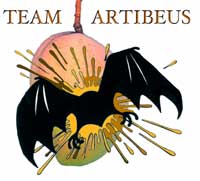
DIET Different species of bats eat different foods. In the northern Lesser Antilles, many bats eat only insects, others specialize on fruit (mangos, papayas, figs) and flowers, and one even catches fish and insects that float on the surface of ponds and streams. Throughout the region, most of our captured fruit bats are covered in fruit juice and fruit pulp (see our Artibeus-Mango T-shirt logo at left). Elsewhere in the world, bats may eat small lizards, birds, and 3 species actually do feed on blood. Not to worry, Vampire bats are not found north of Trinidad in this chain of islands. Even where they do occur, vampire bats prefer blood from birds and livestock, (not humans).
Farmers are often upset by crop damage that they attribute to bats. They are mistaken, it is the birds that must initiate damage to fruit with their sharp beaks... floowed then by the bats and their small teeth to finish the job. Bats do not eat vegetables (usually), but they have been known to eat young pigeon peas before the pods become too difficult to open. In a pinch, fruit bats may supplement their diets with the occasional insect. Many species of bat rely on on open streams and ponds where they drink whilst flying (a thirsty business). If you watch carefully, you will see bats skimming over the surface of a pond or swimming pool, taking in a sip of water.
Female A. jamaicensis with pup
(Photo A. Hartpence)REPRODUCTION Bats are not rodents. Rodents produce large numbers of young throughout the year. Bats in the Neotropics give birth twice a year (maybe just once), and then to only a single young. These very low reproductive rates mean that if bat populations are reduced (i.e., volcano, hurricane, draught, human disturbance), it may take a very long time for the populations to recover.
Births often occur in the wet season so that babies are born when there is plentiful food to be found– i.e. when fruit trees are fruiting/flowering. Baby bats are especially vulnerable while they remain in their roosts because they cannot fly for the first few weeks of life. Bats may not breed until their second or third year of life. Mothers often mate immediately after giving birth to the first pup and are pregnant with their second pup while they are suckling the first.

BAT ROOSTS Bats do not build nests, nor do they modify a structure by chewing/digging.
Nobody should deliberately disturb bats at their roosts, as this could cause them to abandon the roost and their young - disturbance should be kept to a minimum. Mother bats congregate to birth and suckle their babies at so-called 'nursery roosts'. If these critical sites destroyed, then the bat population's reproductive output for that year would be lost with them.
Anyone interested in catching or handling bats should make inquiries to the relevant wildlife/forestry organizations on each island. New roosts should be reported to organizations concerned with wildlife conservation on each island who are tracking sites on each island that are important to bats.
Bat feces either contain identifiable seeds, or insect parts (shiny specks of insect exoskeleton = hard shiny covering of bugs). Conversely, rodent feces are chalky or smudgy in consistency. Most bat roosts are very quiet as bats are usually secretive and do not wish to draw attention to themselves. However, the pig-nosed bat (Brachyphylla) forms large colonies that can be heard and smelled some distance away from the opening to the cave. Other types of fruit bats roost in small clusters 5-20 animals (Artibeus, Ardops). Insectivorous bats, such as Molossus, and Tadarida, live in large groups (5-5,000). The unusual Funnel-eared bat (Natalus) prefers to hang in small numbers from the ceilings of their caves. Bat droppings, noise levels, and clustering behavior are useful aids when trying to identify what species of bat are living in a roost (see table below).
(photo Merlin Tuttle)IMPORTANCE OF BATS Bats are the only native mammals known to occur throughout the region - monkeys, rats, mice, agoutis, and mongoose were all introduced to the island by man. Several species of bat found in this region are endemics, that is, they are not found anywhere else on earth. For this reason alone, these small animals should be protected as an important part of the natural heritage of the Lesser Antilles. However, there are several important reasons for conserving bats.
INSECT CONTROL - Many bats consume huge numbers of insects nightly. The free-tailed bats can eat several hundred insects each evening, and though their presence in your home may be an inconvenience, they are not free-loaders. A small colony of bats easily pays their rent by eating thousands of mosquitoes in the neighborhood each evening = free pest-control.
SEED DISPERSAL - Many fruit bats carry fruit and seeds away from the parent plant thereby helping propagate that species of plant. Studies have shown that birds drop fruit seeds underneath the tree in which they are feeding where they rarely germinate. Bats, on the other hand, spread their droppings (in flight) over larger areas. This wide dispersal of seeds by bats is critical in the replanting/recovery of damaged forests (excessive logging, volcanoes, hurricanes) and in some cases, bats (not birds/insects) are the only vector by which new areas can be reforested.
POLLINATION - Fruit production requires pollination of the flowers on the plant/tree in question. Many bats feed on flowers/nectar, and in doing so become covered with pollen. As they visit the next flower, they transfer this pollen and so pollinate new plants. Many trees that are of economical importance to humans are pollinated by bats, i.e., calabash, mango, banana, and cashew. In fact some trees in the forest are pollinated ONLY by bats. That is, if the bats become endangered, so are the bat-specialized trees. If these trees are lost, then all the other animals that depended on the trees for food or shelter may also be lost, and some of these animals will also be pollinators or seed dispersers for other tree species, and so on. Therefore, the loss of bats from an ecosystem may set-off a devastating cascade of effects throughout the ecosystem - for this reason some bats are called "keystone species", after the keystone that symbolically holds up an entire building.
(photo K. West)THREATS TO BATS Over-development of an island may deplete natural springs that are absolutely critical for the maintenance of healthy forested ecosystems. Without the water, the forests die back - without the forests, the wildlife dies out - with neither the forests nor wildlife, tourists will have little reason to visit an island.
Despite the valuable roles that bats play in maintaining the health of the forests, they are vulnerable to several threats - humans being the worst threat of all. It is important to keep in mind that roosts are a precious resource... bats can't just be relocated to somewhere else, they are too specialized for that.
If human development destroys the roost then a large proportion of the population will be lost in a single event. Mother bats congregate to birth and suckle their babies at so-called nursery roosts. If these critical sites destroyed, then the bat population's reproductive output for that year could be lost with them. Bats also depend on special foraging habitats to hunt for insects and/or fruit. Damage to these habitats can be catastrophic to the bats as well.
SPECIES PROFILES
The following links will provide a very brief description of some of the more obvious features of each species. A few details might need a bit of explaining for the novice: (1) Body measurements are mainly used by people identifying bats in the hand. The length of the forearm (millimeters) is often used as a measure of bat size. One might imagine that body weight would also be a good measure of size in bats, however, bats can eat a tremendous amount of food in a very short time, as such, body weights vary greatly and are not a consistent measure of size throughout the night. Scientific (Latin) names are used to avoid confusion amongst scientists who might otherwise apply "local" names to each type of bat using their own native tongue. As such, the scientific name of each bat consist of two parts - a genus-name and the species name. For convenience, the genus name can be abbreviated, i.e., Artibeus jamaicensis = A. jamaicensis.
FRUGIVORES NECTARIVORES INSECTIVORES CARNIVORES Artibeus jamaicensis Monophyllus plethodon Molossus molossus Noctilio leporinus Artibeus lituratus Glossophaga longirostris Tadarida brasiliensis Artibeus schwartzi Anoura geoffroyi Natalus stramineus Artibeus planirostris Micronycteris buriri Brachyphylla cavernarum Brachyphylla cavernarum Myotis dominicensis Chiroderma improvisum Myotis martiniquensis Ardops nichollsi Pteronotus davyi Sturnira angeli Pteronotus rubiginosus Sturnira lilium Eptesicus fuscus
IDENTIFICATION KEY TO BAT ROOSTS RESIDENT CLUES/OBSERVATIONS Birds/Lizards Droppings: hard, white “chalky” bits in/on them Rats/Mice Droppings: black, hard (not crumbly), 'smudgy' Fruit Bats:
Artibeus, Monophyllus

Cave + Droppings are dark “splats” (maybe with little seeds) splashed onto walls or appearing in wet piles on floor. Animals grouped in small, tight clusters Fruit Bats:
Brachyphylla

Cave + Loud raucous groups of bats + Droppings are dark “splats” (maybe with seeds) splashed onto walls or appearing in wet piles on floor. Animals grouped in large, tight clusters Fruit Bats:
Artibeus, Monophyllus

Hollow tree/Tree cavity + Droppings are dark “splats” (maybe with seeds) splashed onto trunk or appearing at base of tree. Animals grouped in small, tight clusters Fruit Bats:
Artibeus, Ardops


Canopy/Live tree + Droppings are dark “splats” (maybe with little seeds) splashed onto trunk or appearing at base of tree. Grouped in small tight clusters. Fishing Bat
Noctilio

Shallow cave/Cliff face/Hollow tree trunk + Large droppings (>1cm) + fish scales/insect parts + Smells absolutely horrible! Grouped in clusters. Freetailed Bats
Molossus, Tadarida

Human dwellings/Shallow caves, Rock fissures + Small formed droppings (<1cm) + crumbly with lots of shiny specks (insect parts). Animals grouped in tight clusters. Funnel-eared Bat
Natalus

Caves + Small orange bats hanging randomly across the roof of the cave + spaced apart from each other (>1m)
SIMPLE IDENTIFICATION KEY TO BATS IN THE REGION.
Moving from left to right through this simplified table should allow you to accurately identify just about any bat in the region north of Guadeloupe and east of the Virgin Islands
SMELL? TAIL/MEMBRANE? NOSELEAF? FUR?
SIZE?
SPECIES
Rancid
fishYes - tail does not extend
beyond tail membraneNo Orange with white stripe down middle of back Large
FA = 83-89mmNoctilio
leporinusYes - tail does not extend
beyond tail membraneNo Orange with buff colored belly Very small
FA = 37-40mmNatalus
stramineusYes - tail extends beyond
tail membraneNo Light brown, ears meet above eyes, wrinkled upper lips Small
FA = 36-39mmTadarida brasiliensis Yes - tail extends beyond
tail membraneNo Dark brown, ears meet above eyes, unwrinkled upper lips Small
FA = 36-39mmMolossus molossus Short tail - no tail membrane Yes - but round, stumpy Whitish-yellow to buffy-brown Large
FA = 61-69mmBrachyphylla cavernarum Short tail that sticks our beyond a small tail membrane Yes - small, heart-shaped Dark brown fur, bristle-like whiskers encircle noseleaf Medium
FA = 39-43mmMonophyllus plethodon No tail - Narrow tail membrane on inner surface of each leg Yes Grayish brown, faint white stripe down middle of back Large
FA = 59-60mmChiroderma improvisum No tail - Narrow tail membrane on inner surface of each leg Yes Medium length brown hair, often faint stripes above eye Large
FA = 60-69Artibeus jamaicensis No tail - Narrow tail membrane on inner surface of each leg Yes Long, fluffy, light-brown hair, white tufts of fur on shoulder Medium
FA = 50-54mmArdops
nichollsiNo tail - no tail membrane Yes Orange shoulder patches (faint) Large
FA = 45mmSturnira
angeli
SCOTT PEDERSEN, PhD,
Professor, Department of Biology and Microbiology, SDSU, Brookings SD 57007.
Pedersen's research efforts have strayed significantly from his formal training in craniofacial development and evolution to focus rather on a study that literally fell into his lap; a natural experiment in island biogeography and biodiversity on the small island of Montserrat. Over the last 25 years, Montserrat has been severely damaged by hurricanes and volcanic eruptions. Variation in the local fruitbat population has accurately reflected the accute environmental damage caused by each natural disaster. Pedersen has sampled nearly 20 neighboring islands to serve as natural controls for what is being recorded on Montserrat.

MATHEW MORTON, BSc
Durrell Wildlife Conservation Trust Les Augrés Manor, Trinity, Jersey JE3 5BP, matthewnmorton@hotmail.com
Morton initially developed an interest in bat faunas whilst surveying dwarf crocodiles in West Africa, following this up with bat detector surveys, radio-tracking and bat conservation work in the UK. Over the past ten years he has visited a number of islands in the Eastern Caribbean, focusing on basic inventories of local bat populations, and training local conservation workers, both within government and NGOs, to equip them with the basic techniques needed to monitor bats in their countries and make effective conservation management decisions. This work has often put an emphasis on roost sites as a first phase in conservation management. Education and outreach has also proved important as the ecological roles of bats and their importance to each islands natural heritage has often gone under appreciated. This guide grew out of smaller per-island guides that have been produced over the years as outputs from the capacity building undertaken in these countries.

